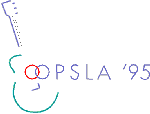 Business Object Design and Implementation Workshop
Business Object Design and Implementation Workshop
 Business Object Design and Implementation Workshop
Business Object Design and Implementation Workshop
 Position Paper
Position Paper CORBA as a platform for 3-tier systems
CORBA as a platform for 3-tier systems
 Thomas Grotehen and Rene Schwarb
Thomas Grotehen and Rene Schwarb Organization
Organization
 Date/Place: 16 October 1995/Austin, TX
Date/Place: 16 October 1995/Austin, TX
After an evaluation of the Common Object Request Broker Architecture (CORBA) we plan to introduce a CORBA based 3-tier architecture for the development of different systems.
The evaluation has been carried out in order to verify the this architecture in a large scale financial environment including legacy systems. Facing this challenge we implemented several client- and server-applications based on different legacy systems. The server applications run on UNIX machines, access other UNIX, CTOS and MVS machines, allowing access from UNIX and Windows 3.1 as well as Windows NT. They are based on IMS- and DB2 transactions, different interfaces to these transaction systems, Sybase Open Servers, a document generator and an interface to an electronic document management system.
We believe that this approach can beneficially be used today in large scale systems. In our case, one of the main benefits is that CORBA can help to solve current problems (integration of legacy systems, use of heterogeneous development tools, etc.) as well as future problems (migration to an open systems architecture), allowing to use new and legacy systems at the same time.
The 3-tier approach we plan to introduce in different projects consists of a presentation tier, a business object tier and a data tier. The two interface layers between presentation and business object tier, and business object tier and data tier will be specified in CORBA IDL.
We believe that this approach enhances reuse of design specifications (IDL specifications for BO and data object interfaces) as well as implementations of business and data objects.
 Business Object Design and Implementation
Business Object Design and Implementation